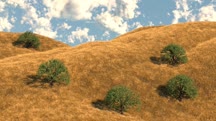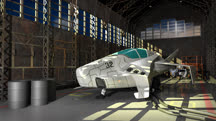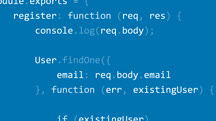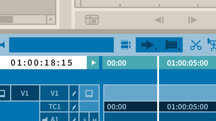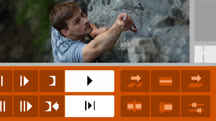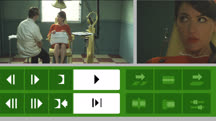Course catalog
Categories
Showing 5,781-5,800 of 9,135 items.
Maya: Natural Environments (223989)
Representing the natural world in a 3D program can be a daunting task. Autodesk Maya comes to the rescue with an incredible array of tools for world-building. In this course, learn how to command the powers of Maya to model, sculpt, and shade scenes of nature. Terrains can be imported as heightmaps, generated with procedural texture patterns, sculpted by hand, or art directed with any combination of those methods. With tools such as XGen and Paint Effects, you can easily populate a scene with plants and other objects. The layout requirements for exteriors often include special visual effects such as image planes and camera constraints. Volumetric clouds and atmospheric perspective complete the illusion of reality for a photorealistic natural setting. This course even touches on real-time workflows, rendering a cubic environment map in Maya and loading it into Unity. Get ready to tame the wilderness and design realistic exterior settings in Maya.
Maya: nHair
Learn to create, style, animate, and render realistic hair with Maya nHair.
Maya: Render Setup System
Learn how to use the Render Setup window and the Light Editor to create faster, more dynamic renders in Maya.
Maya: Rendering in Arnold 6
The Arnold renderer in Maya makes photorealism easier than ever. Learn to light, shade, and render using the powerful tools in Arnold 6.
Maya: Retopology for Animation
Learn how to use the Maya modeling toolkit for retopology: rebuilding a model for smoother and more natural animation.
Maya: Shader Networks
Learn to create complex materials and shader networks in Maya, the industry leader in 3D materials and shaders.
Maya: Time Editor
Learn how to reuse, blend, and move animation between characters with the Time Editor in Maya 2017.
Maya: Tips, Tricks & Techniques
Get tips, tricks, and techniques to solve the most common issues Maya artists encounter in a live production environment in this new series.
MEAN Stack and MongoDB: Development Techniques
Learn how to develop web applications and web APIs with the MEAN stack: MongoDB, Express.js, AngularJS, and Node.js.
Measure Salesforce Effectiveness
Don't miss opportunities to improve your sales team's performance and increase revenue. Learn what you need to measure to determine if your salesforce is effective.
Measure What Matters (Blinkist Summary)
Leverage the power of objectives and key results (OKRs) in your organization. In this audiobook summary learn how to use this time-tested technique to achieve measurable goals.
Measuring Business Performance (216271)
All companies are looking for that perfect metric, the one data point that will tell them everything they need to be successful. Measuring errors abound, but developing better metrics can be difficult. In this course, ASU instructor Eddie Davila walks you through how to create metrics that work well for your company. Eddie explains why it is important to measure performance and what some of the most common errors are in measuring your own company’s performance. He goes over what makes a good metric, how to evaluate your current measurement system to see if it aligns with your organization goals and how you can develop and test a system of measurement from scratch. Eddie also covers the importance of data visualization tools, such as dashboards and infographics.
Measuring Learning Effectiveness
Determine the ROI for learning. Learn how to measure the learning effectiveness of your class or training program using popular training evaluation models.
Measuring Team Performance
Learn how team measurement works, why and how you do it, and how to apply it to specific functions such as sales, operations, and finance.
Media Composer 2019 Essential Training: 101 Fundamentals 1
Get up and running with Avid Media Composer. This project-based course covers each aspect of the editing process—from importing media to exporting a complete video sequence.
Media Composer 2019 Essential Training: 110 Fundamentals 2
Learn to import, edit, refine, and output video using Avid Media Composer.
Media Composer 2020 Essential Training: 101 Fundamentals 1 (224414)
Get up and running with Media Composer, the feature-rich video editing software from Avid. In this project-based course, the first installment in a two-part series, learn how to approach each aspect of the editing process with Media Composer 2020. After familiarizing you with the software's interface, Maxim Jago—an Avid Certified Instructor with 20 years of experience—demonstrates how to create a brand-new project and import media. He then helps you get comfortable with each stage of the editing workflow. Learn how to prepare the timeline for editing, add audio and effects, create titles, manage media, export a video sequence, and much more. Maxim thoroughly explains each technique within the post-production workflow, using real-world examples along the way.
This course is an official companion to Media Composer 101: Media Composer Fundamentals I, the introductory book from Avid. In each chapter, Maxim expands on the lessons and exercises found in the book. Together, these resources can help novice users quickly start leveraging this powerful software.
This course was created by Maxim Jago. We are pleased to host this training in our library.
This course is an official companion to Media Composer 101: Media Composer Fundamentals I, the introductory book from Avid. In each chapter, Maxim expands on the lessons and exercises found in the book. Together, these resources can help novice users quickly start leveraging this powerful software.
This course was created by Maxim Jago. We are pleased to host this training in our library.
Media Composer 2020 Essential Training: 110 Fundamentals 2 (224431)
Learn to import, edit, refine, and output video using Avid Media Composer. This course is the second part of a two-part, start-to-finish, project-based training series designed to get you up to speed on the Media Composer environment in context of the Avid Everywhere model. Maxim Jago —an Avid Certified Instructor with 20 years of experience—focuses on getting users comfortable with each aspect of the editing process—from preparation and organization, to editing and trimming video, to audio mixing and effects, to media management and output. You can also learn creative techniques for retiming footage, tracking and blurring objects, creating precise mattes, and more. Each technique within the post-production workflow is explained thoroughly and concisely, using real-world examples from a documentary-style promotional project.
This course is an official companion to Media Composer 101: Media Composer Fundamentals I, the introductory book from Avid. In each chapter, Maxim expands on the lessons and exercises found in the book. Together, these resources can help novice users quickly start leveraging this powerful software.
This course was created by Maxim Jago. We are pleased to host this training in our library.
This course is an official companion to Media Composer 101: Media Composer Fundamentals I, the introductory book from Avid. In each chapter, Maxim expands on the lessons and exercises found in the book. Together, these resources can help novice users quickly start leveraging this powerful software.
This course was created by Maxim Jago. We are pleased to host this training in our library.
Media Composer 8.7 Essential Training: 101
Learn the basics of video editing in Avid Media Composer. Learn how to import, edit, and output high-quality, professional video, complete with titles and effects.
Media Composer 8.7 Essential Training: 110
Enhance your editing skills with Avid Media Composer. Learn advanced editing techniques to recut scenes, mix audio, work with high-res video, and apply effects and animation.
